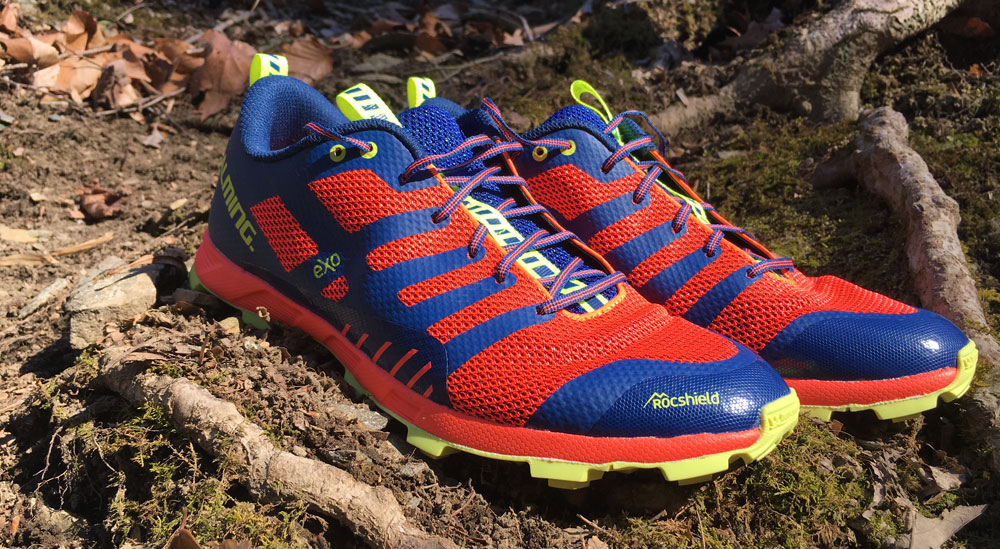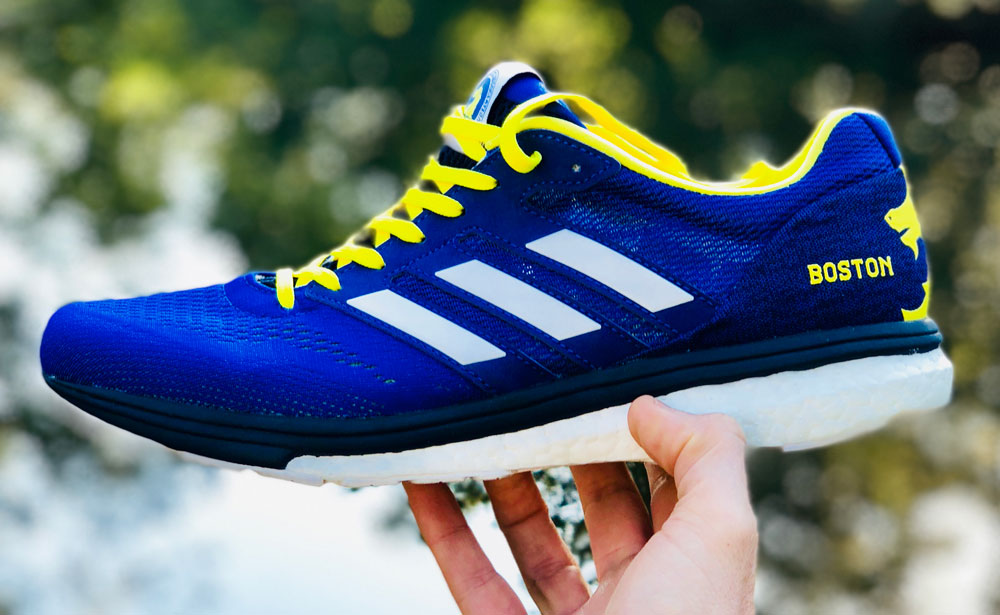
Robbe: Grip it and rip it. If there was ever a shoe made for mud and water, the Salming OT Comp (Off Trail Competition) is the one. Granted, it was designed specifically for obstacle course racers, orienteers, and SwimRun competitors (an event where you actually keep your shoes on while swimming between runnable land masses). However, it crosses over into trail running with relative ease. I took the shoe for a combined 37 miles on a short hike, a freak snowy run in Baltimore city, and a trail 50k in northeast Maryland.
The first step-in felt pretty good. It’s a narrow shoe (which I prefer), and when the quick-drying flat laces are cinched down, it felt perfectly snug. On my first walk around the house, I felt like a tree-frog, as the outsole literally stuck to my wooden kitchen floor (more on this ridiculous grip later). The shoe is wonderfully light, coming in at 9 oz. for a size 10. The upper on this shoe is a light mesh that drains like a sieve; I submerged them in a creek during the HAT 50k and within minutes they were back to normal. I should say I was not wearing wool or quick-drying socks, so any noticeable extra weight can be placed square on the shoulders of my sock choice. This shoe is hyped by Salming as the premier swim run shoe, and I have no problem recommending it in that regard, assuming the race portions are on trails. I can’t imagine a shoe that is better.
The other delightful component of this shoe is the rubber Michelin outsole designed with OCX (Extreme Outdoor Compound), a sticky compound that exhibits extreme adherence to wet and slippery surfaces. When crossing creeks and stepping on wet stones, I found no slippage. The same can be said for slushy and snowy city sidewalks (say that ten times fast). The actual lug design on the outsole is based on Michelin’s design for their acclaimed mountain bike and motocross tires. The lugs are spaced far enough apart that the shoe is self-cleaning– meaning no gunked up mud adding extra weight ot the shoe. The lugs are almost an inverted pyramid type shape and are a full 7mm long, allowing for deep penetration into thick mud. In essence, they’re a bastard son of a cleat. And boy do they grip. Three days before my trail race, it snowed 8 inches, only to be followed by warm weather that inevitably turned the trails to mud on the second loop of the race. I reserved my energy for this loop and started bombing the hills— muddy, rocky, rooty hills. I attacked them with everything I had (honestly, a little bit recklessly) and I swear I didn’t slip once.
The shoe also features a RocShield reinforcement area on the toe, which… shields rocks (and does its job fine). The outsole is connected to the midsole with Michelin Fiber Lite technology that combines extreme lightness with a durable textile layer. With a 4mm drop, it rides that perfect balance between an Altra and a heavily-cushioned shoe. I found it to be pretty responsive in muddy conditions, but in good conditions, it felt firm. I’m fully aware these shoes were made for those types of conditions, so I’m not terribly disappointed that the gnarly lugs probably didn’t feel like a plush ride on packed dirt or road.
Erin: I’ve never run in a shoe quite like the Salming OT Comp. OT Comp is short for “off-trail competition,” a description that confuses me somewhat. It was designed for obstacle course racing and swim-run competitions, neither of which I’ve ever done. In fact, I never knew swim-runs were even a thing until recently. I’ve been told that during these events, runners will either swim with their shoes on, or they’ll take them off and stick one shoe down the front of their shorts and the other shoe down the back, swim across, and put their shoes back on. Sounds terrible, guys, why would you do that? Salming’s got you though.
Because I’m not a complete masochist, I wore these for trail running only, but if I end up being chased into the water by a bear or something (I know bears can swim, give me a break) I’d want to be wearing these. The upper is mesh and drains very quickly. The overlays on the midfoot help provide some stability there, and there’s reinforcement along the toebox called Rocshield.
The midsole is Salming’s Runlite; Google wouldn’t tell me what the composition of Runlite is, but I assume it is standard EVA. It’s responsive, and there’s not much in the way of cushioning, as per usual with Salming shoes. The OT Comp has a 4 mm drop. Probably the most remarkable and noticeable feature of these shoes is the outsole, which is made of Michelin OCX and is modeled after Michelin mountain bike and motorbike tires. The lugs on these guys are aggressive; the tallest lugs measure 7 mm. They are spaced somewhat far apart, though I haven’t had any issues with rocks getting stuck in there. I assume the spacing is to aid in the “self-cleaning” feature of the shoe. At first, I was like yeah, ok, whatever that means, but they really do clear mud and debris very well.
The first thing I noticed when I put these on and walked around is how tacky the outsole is; this is also by design. And man, these provide the best traction of any trail shoe I’ve ever worn. I’ve done several stream crossings with wet rocks and felt very secure. You could probably scale a building in these. Is that a part of obstacle course racing? I don’t know.
Like other Salming shoes, these will get you noticed. Both the men’s and women’s models have the same colorway, which is called Lava Red, though it looks more orange to me. They’re pretty sweet looking. The tongue even has a little padding! And a pull tab so you can adjust it easily if it moves!
Shop Salming OT CompRobbe: I want to preface the bad by saying this isn’t technically a trail running shoe (I mean, it’s called Off-Trail Competition), and since we don’t do much obstacle course racing here at Believe in the Run, and since there’s only one official SwimRun event in the U.S. at the moment, I had to test it in the closest environment I could get.
I’ll get the worst part out of the way. I broke these in by hiking maybe two miles on a low-grade trail carrying my kid in a backpack. I got home and thought, ‘That’s odd, the ball of my foot hurts.’ Next, run in the snow– ‘Yeah, it definitely hurts. Maybe it’s just cause of when I had to hop on the sidewalk.’ And here I sit typing this, two weeks after my 50k, and the ball on my foot still hurts at times when walking around. Apparently, one of the lugs was right under the ball of my foot and was just mashing it. I can forgive it for maybe hurting a bit after a long trail race, but I especially didn’t like that it hurt even after a two-mile hike. Now, my other foot felt perfectly fine, no problem at all. So this may just be a problem specific to me, or others who are unlucky enough to have a lug at the wrong place on their foot.
While these shoes are great in awful conditions featuring water and mud, they are not a shoe for firm surfaces. A portion of my race was on the paved section and they were super firm. It felt like running in soccer cleats. I feel like a little more cushioning could be added to the midsole to balance out the ruggedness of the lugs. I will forgive some of this as the temperature was hovering around freezing. I feel like every review I’ve done in the last six months I’ve had to do with shoes in freezing or below freezing temps, which has been shown to provide a much firmer ride (almost like a worn-out shoe).
One more thing- if you’re a large fella, look elsewhere for your size– this one only goes to 12 (but perfect if you’re the lead guitarist of Spinal Tap).
Erin: These are awesome shoes, and I think they’re definitely great for certain trail situations in addition to whatever obstacle/swimming B.S. you want to get into. However, their utility, I think, is limited to technical or slick surfaces only. You could wear them for shorter trail runs or races that are less technical, but the lugs start to cause a little discomfort on smoother surfaces and during longer runs. If you wear them on the road, it feels like running in cleats, so I’d avoid that.
Robbe: If it wasn’t for the unfortunate placement of the lug on my left outsole, I would wear this shoe on any trail in poor conditions. It really did amaze me how much the Salming OT Comp gripped everything. I could take hills that others were tiptoeing down, without fear of slipping off the side of the single track. If you’re reading this review as someone who the shoe was designed for (off trail competitors), you should definitely give it a try.
I also want to give a shoutout to Salming as a company. I had a couple questions regarding the shoe, and after sending a general inquiry to the customer service, I got an immediate response from their CEO. You don’t get that too much these days. All that to say, you can tell Salming put a lot of thought and effort into designing a shoe for a relatively small corner of the market. While this might not be the best option for typical trail running, it is perfect for those off-trail competitors, as well as certain trail runners — anyone climbing, orienteering, hallucinating and sometimes running their way through the Barkley Marathons.
Erin: The Salming OT Comp really impressed me. I wish I could provide some information for you obstacle course racers, but I do think this shoe would be great for that type of environment. There seems to be a lot of mud and climbing over things in the OCR world, so if that’s your thing, get yourself a pair of the OT Comp and I don’t think you’ll be disappointed. For trail runners, if you like the INOV-8 Roclite, I think you’d enjoy these as well.
Have something to say? Leave a Comment


Interesting review. I bought this shoes for orienteering, as a replacement for my Inov8 oroc 280, which i wore out.
My impressions are a bit opposite.
Fit is perfect. I have no sores after long races. Also, they have sort of cushion, and even running on the tarmac or hard pavement is uncomfortable, like in Oroc or VJ Supra. They feel more like road racers.
But, traction on wet steep slopes is not enough. I tested it in extreme conditions – I ran orienteering course in heaviest rain, down on muddy steep trails and across forested slopes. It was very dangerous, and I felt into the mud and dirt couple of times. But that’s not very common conditions, and many similar shoes with rubber soles would fail too. Only aggressive metal spikes would save traction in such conditions, like VJ Supra Spike.
The other good thing about these shoes, they made from material easy to clean. After orienteering race in wet weather and dirt, shoes usually look like sh*t. But I thoroughly washed it, and they are like new again.